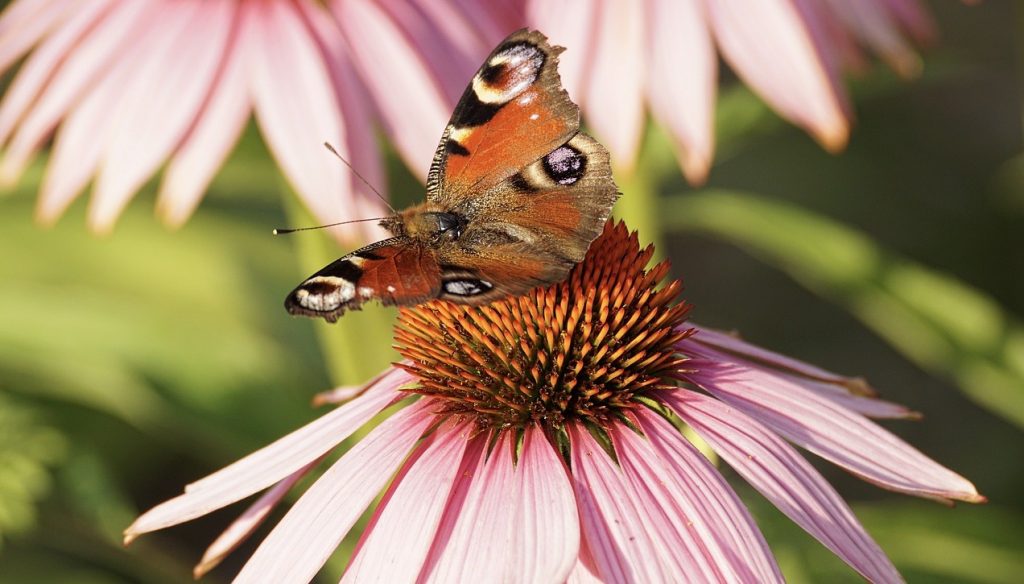The benefits and uses of echinacea – and how to grow your own!
(Wake Up Word | Dr. Joseph Mercola) Echinacea, commonly known as coneflower, is a member of the Asteraceae family, a large plant family composed of 23,600 species. Well-known members of this family include dandelion, cudweed, artichokes, lettuce and sunflower. It is considered to be an economically important group because many of its members are cultivated as food crops.1
Native Americans were the first to use echinacea over 400 years ago. Before the rise of antibiotics, it was used as a general cure for various infections and wounds, such as malaria, scarlet fever and syphilis.2 There are over a dozen varieties of echinacea, and they can grow anywhere from 1.5 to 5 feet in height. Each variety has its own unique color, making the Echinacea family a popular fixture in gardens throughout America.3
Benefits of using echinacea
Centuries ago, Native Americans primarily used echinacea to help treat the common cold. It still serves that purpose today, but its uses have expanded to:
Boosting your immune system: The compounds in echinacea may help improve your immune system. In a study published in Integrative Cancer Therapies, echinacea has been shown to help reduce the severity and duration of colds if it is administered right away once symptoms appear. However, if you use echinacea several days after getting a cold, it won’t have much of an effect.4
Fighting against bacteria and viruses: echinacea contains a compound called echinacein, which can help against bacterial and viral infections. According to a study in Pharmaceutical Biology, echinacea exhibited antimicrobial properties and is effective against 15 different pathogenic bacteria and two pathogenic fungi.5
Speeding up wound healing: When applied to a wound, echinacea may help speed up the formation of new skin cells, while helping prevent an infection thanks to its antibacterial properties. According to a study in the Journal of Ethnopharmacology, the compound responsible for echinacea’s wound-healing benefit is echinacoside, which is present in several varieties of the flower.6
Aside from these benefits, echinacea may also help treat the following conditions:7
- Flu
- Urinary tract infections (UTI)
- Vaginal yeast infections
- Herpes
- HIV/AIDS
- Human papilloma virus (HPV) infections
- Bloodstream infections (septicemia)
- Tonsillitis
- Streptococcus infections
- Syphilis
Other uses of echinacea
Echinacea is a popular fixture among gardening enthusiasts. All varieties of echinacea have their own unique colors, allowing you to mix and match them with other flowers and shrubs.8 It’s also good to know that they retain their beautiful bloom for months, which translates to minimal garden maintenance.9
Echinacea plays a vital role in the environment as well. Thanks to its long blooming season, it is known for attracting bees, helping encourage pollination and the production of honey. It can attract butterflies as well, providing food for these beautiful winged insects so they can reproduce and lay eggs.10
How to grow and harvest echinacea in your own home
Growing and harvesting your own echinacea is relatively easy, as it can grow in many types of soil. However, it does take time before it fully matures and becomes ripe for harvesting. But before you start planting echinacea in your garden, here are a few things you should know about:11
- The plant grows best if the soil has a pH level between 6 and 8.
- Well-drained soil is necessary to produce high-quality flowers.
- It requires full sunlight.
Once these three requirements are met, you can begin planting echinacea by either purchasing seeds, nursery stocks or plant divisions, placing them half an inch under the topsoil. Once planted, cover the soil under 2 inches of mulch as it helps retain soil moisture and lessens the need for watering.12
When watering the flowers, supply them with up to 1 inch of water every week during the dry season. During the rainy season, you don’t need to water them because the weather will provide enough moisture for them to grow. Make sure to water only the soil and not the flowers themselves, as it can damage the plant.13 Echinacea typically blooms after two years during the summertime, but it can happen during late fall as well.
Making homemade echinacea tea
One of the easiest ways to obtain the benefits of echinacea is brewing homemade tea. Before you go to the garden and pick flowers though, please follow this process to ensure a high-quality yield:14
- To get the best flavor, harvest the flowers when they’re in their second year just as the buds are beginning to open.
- Cut through each flower stem with shears, making sure that you make the cut just above the topmost leaf.
- Strip the leaves and cut off the flower buds just behind the flower head. Dispose of the stem as you don’t need that to make the tea.
- Dry the flowers. Spread out the buds and leaves on a drying screen in a dry room with good air circulation, because intense heat can destroy the flower’s flavor. Keep them in the room for one week or until they feel brittle. Afterwards, store the dried plants in a sealed container to maintain freshness.
Homemade organic echinacea tea
Ingredients:
- 1/4 cup dried echinacea flowers
- 8 ounces filtered water
- 1 to 2 tsp. raw honey
Directions:
- Bring the water to a boil over medium heat in a small pot.
- Once the water starts to boil, add in the echinacea flowers.
- Cover the pot and let it simmer for 15 minutes.
- Strain the tea into a mug and add honey as needed.
Using echinacea essential oil
Making echinacea essential oil is a simple process. Harvesters simply take the top 15 centimeters of the best flowers and distill them to produce the oil.16 You can use echinacea oil through these methods:17
- Antiseptic: Rub a few drops of the oil on your wound to help speed up healing and kill bacteria, which can help prevent it from becoming infected.
- Bath soak: If you want to feel the benefits of echinacea throughout your body right away, place a few drops of it in your bathwater and soak in it. Alternatively, if you don’t have the essential oil, you can use dried echinacea tea bags.18
- Massage: Using echinacea oil for massages will allow you to reap its benefits immediately. Apply it on your chest and back to help treat your colds, or you can use it on your head for a relaxing head massage.
Remember this before using echinacea oil
Before heading off to purchase echinacea oil, you need to be aware of its potential side effects. Taken internally, echinacea oil can upset your stomach. In other cases, it can cause allergic reactions such as rashes, asthma and anaphylaxis, which can be life-threatening.19
If you’re allergic to a flower belonging to the daisy family, you’re most likely allergic to echinacea as well. Those who have asthma or atopy will also have a higher risk of an allergic reaction when using echinacea. Examples of daisy plants include marigold, ragweed and chrysanthemum.20
Even if your doctor confirms that you’re not allergic to echinacea oil, it’s best to do a skin test first to check if it can irritate your skin. To perform the test, simply place a drop of the oil on your arm and wait to see if the skin becomes irritated or develops a rash. If irritation occurs, stop using the oil immediately.
Beware of fake echinacea products
Should you have problems growing echinacea in your home, you can purchase echinacea flowers to make your own tea or essential oil instead of buying echinacea products. That’s because there are products labelled as “echinacea,” but do not contain the namesake ingredient.
In a study conducted by ConsumerLab.com, researchers tested 11 brands of echinacea products and found out that only four of them contained the actual flower. The rest didn’t meet the measurements stated in the packaging labels and, even worse, some of them didn’t even contain echinacea at all!21
Sources and references:
- 1 Encylopaedia Britannica, “Asteraceae”
- 2 “Nutrition: Science, Issues, and Applications,” 2015
- 3 Cornell University, “Coneflower, Purple”
- 4 Integrative Cancer Therapies, “Immune System Effects of Echinacea, Ginseng and Astragalus: A Review” Sepetember2003
- 5 Pharmaceutical Biology, “Echinacea. Extracts Contain Significatn and Selective Activities Against Human Pathogenic Bactera” October 7, 2008
- 6 Journal of Ethnopharmacology, “Anti-Inflammatory and Cicatrizing Activity of Echinaceapallida Nutt. Root Extract” February 2002
- 7 WebMD, “Echinacea”
- 8 Rodale’s Organic Life, “Grow Your Own Echinacea” July 24, 2015
- 9 Garden Design Magazine, “14 Colorful Coneflower Varieties to Grow”
- 10 Natural Living Ideas, “10 Reasons Echinacea Should Grow in Every Garden” April 20, 2016
- 11 Off The Grid News, “Growing and Using Echinacea”
- 12, 13 SFGATE, “How to Water Coneflowers (Echinacea)”
- 14 SFGATE, “How to Harvest Echinacea for Tea”
- 15 The Paleo Mama, “Homemade Echinacea Tea” July 21, 2015
- 16, 17 Ontario Ministry of Agriculture Food & Rural Affairs, “Echinacea”
- 18 Health on a Budget, “Allergy Relief and Other Health Benefits of Echinacea Tea”
- 19, 20 National Center for Complementary and Integrative Health, “Echinacea”
- 21 ConsumerLab.com, “Many Echinacea Supplements Don’t Meet Quality Standards According to ConsumerLab.com”
About the author
Born and raised in the inner city of Chicago, IL, Dr. Joseph Mercola is an osteopathic physician trained in both traditional and natural medicine. Board-certified in family medicine, Dr. Mercola served as the chairman of the family medicine department at St. Alexius Medical Center for five years, and in 2012 was granted fellowship status by the American College of Nutrition (ACN).
While in practice in the late 80s, Dr. Mercola realized the drugs he was prescribing to chronically ill patients were not working. By the early 90s, he began exploring the world of natural medicine, and soon changed the way he practiced medicine.
In 1997 Dr. Mercola founded Mercola.com, which is now routinely among the top 10 health sites on the internet. His passion is to transform the traditional medical paradigm in the United States. “The existing medical establishment is responsible for killing and permanently injuring millions of Americans… You want practical health solutions without the hype, and that’s what I offer.”
Source: Wake Up World
You may also like:
Exotic honey comes to rescue in fighting deadly C. difficile infections
Farmers are now using flowers to help reduce pests instead of harmful pesticides




